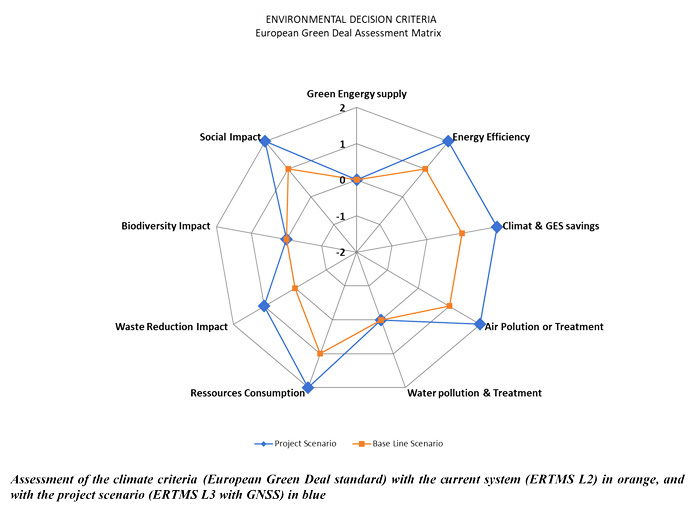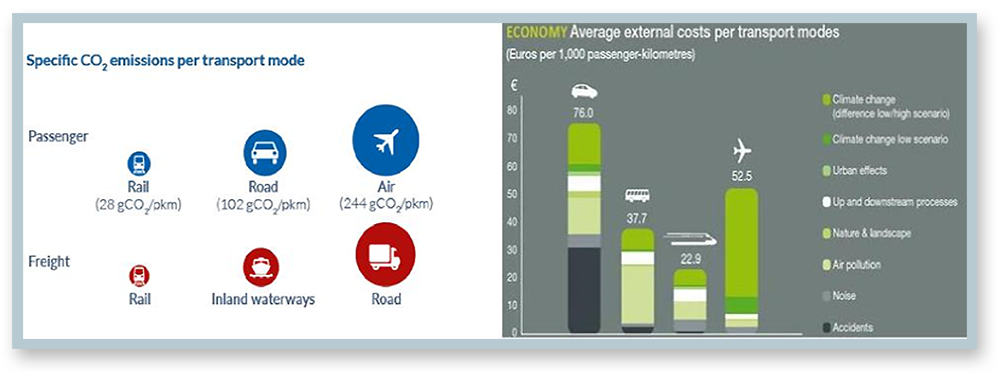CLUG 2.0 is fully in line with the Work Program and the expected impacts of the Strategic Plan:

CLUG 2.0 has a real impact on the societal challenges with the development of an interoperable, sustainable and green mobility, decreasing the environmental footprint of the transportation sector. The CLUG 2.0 proposal supports Europe’s ambition for a more resilient, green, digital and strong technological industry. An assessment of the contribution of LOC-OB System to climate ambition based on climate criteria defined in the European Green Deal standard published by the European Commission is presented below:

ENERGY COMSUPTION REDUCTION
The CLUG LOC-OB allows the optimization of train traffic in terms of path allocation, train speed profiles, headway, dwell time, overall timetable regulation, eco-driving with ATO or with Driver Advisory Systems (DAS), energy saving by regenerative braking or coasting.
Reducing energy consumption, the CLUG LOC-OB associated to ATO functionalities will also contribute to reducing the climate changes and the greenhouse effects.
MATERIAL, INSTALATION AND MAINTENANCE REDUCTION
The LOC-OB System principle aims to reduce dependence on trackside equipment for train localisation such as Eurobalises as well as any other device already used for train tracking (within national legacy systems as well as ERTMS). Such devices used for train localisation are typically installed along the track and are not easily repairable and therefore are simply replaced in case of failure. The LOC-OB system is an enabler for the shift toward moving block (ERTMS/ETCS Level 3) and therefore together with onboard train integrity devices offers the possibility for a future railway system without track circuits and axle counting systems. A huge amount of these devices, their cabling for feeding the units along the track and the need to collect and maintain the status of the devices could be avoided thanks to systems such as the CLUG LOC-OB, contributing therefore to waste reduction.
DIGITALIZATION & AUTOMATION
The development of absolute safe train positioning solution suitable across the entire European rail network is a strategic key enabling technology for the future-proof development of train digitalization and automation as one of the greenest means of transportation.

Experience has demonstrated enormous benefits with similar system developed for urban environment (eg ERTMS level 2 for main lines, CBTC for urban lines – metro), such as increased system capacity, punctuality, reliability, flexibility (by real-time adaptation to the demand), as well as reduced energy consumption. With a complete system-chain of digital, interoperable, and automatized systems, from the traffic management system (TMS) input, over automatic route setting, and with an automatic train protection (ATP) system, Localization-Based Train Control (LBTC) can tremendous societal impacts as it will lead to a smoother adaptation of the customers’ needs across railway transport segments, such as regional and suburban trains, high-speed trains, freight trains, light rail and tramways.
SPACE SECTOR COMPETITIVENESS
Involving key players from air, space and rail domains, the CLUG safe LOC-OB System participates to a green mobility industry, bridging space (GNSS/ EGNOS) domain with rail domain (ERTMS/ETCS). Therefore, it supports the development of industrial ecosystems starting from smart sensors manufacturing up to global train control systems (relying on the safe train localisation system) delivery with the use of space-based infrastructures such as EGNOS and EGNSS. The development of systems such as the CLUG LOC-OB developed by European major industrials, will enforce EU’s capacity to develop critical transportation technologies using EGNSS and therefore contribute to fostering the EU’s space sector competitiveness.












